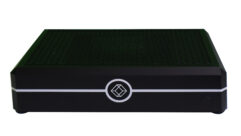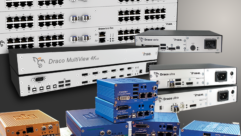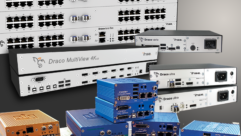Sound & Video Contractor sat down with Rafael Serrano, head of product management, Adder Technology, to discuss the transformational technological developments that have made command and control centers into the secure, yet seamlessly collaborative and user-friendly spaces they have become.
Machine learning, advanced visualization systems with ultra-high-resolution digital displays and video walls, as well as cloud computing and virtualization have all drastically enhanced the efficiency, responsiveness, and capability of mission control rooms. And, as a transport mechanism technology, high-performance IP KVM (Keyboard, Video, Mouse) technology has facilitated merging those technology advancements, providing seamless, secure, and remote system management. Together with the use of ergonomic furniture in the design of the control room, these developments ensure minimal stress on operators so that essential emergency, transportation, and military operations can continue uninterrupted.
Sound & Video Contractor: Depending on the organization, “mission-critical” can mean something different. Please share what you consider a “typical” mission control room.
Rafael Serrano: A typical mission control room is a centralized hub where highly trained personnel manage operations that are critical to safety, security, and continuity of services, often in real-time and 24/7, across various industries such as emergency services, transportation, space, military operations, and Network Operations Centers (NOCs). These rooms are designed with the operators at the core, and are equipped with advanced technological infrastructure to support high-stakes decision-making processes. Key features include extensive display setups such as video walls to provide a global process situation view, as well as multi-monitor desktops to provide a detailed situation view, delivering comprehensive real-time data visualization for fast decision making.
The layout is designed to facilitate quick communication and collaboration among team members and third-party stakeholders, often incorporating ergonomic furniture to reduce physical strain during long hours of operation. Additionally, these control rooms utilize robust and secure networks for data capture, analysis, and sharing, ensuring that operators can access and interpret the necessary information swiftly and accurately. The integration of Internet of Things (IoT) devices, high-resolution graphical interfaces, and VoIP systems further enhances operational efficiency and situational awareness.
S&VC: What technology advancements have dramatically changed how command and control centers are operated?
RS: Technology advancements have significantly transformed command and control centers, enhancing their efficiency, responsiveness, and capability. Key developments include the digital capture and real-time monitoring of data at scale, driven by the Internet of Things, which enhances monitoring and data analysis capabilities. This includes:
- Machine learning (ML) that further accelerates data parsing and understanding, improving both real-time and retrospective analysis.
- Advanced Visualization Systems with ultra-high-resolution digital displays and video walls that provide clarity under pressure and improve situational awareness and decision making.
- Cloud computing and virtualization-based solutions that handle increased data loads and adapt to changing needs quickly.
In addition to the above, mobile and remote access and enhanced communication systems that integrate voice, video, and data with enhanced encryption and cybersecurity facilitate more resilient collaboration and scalability. However, an important aspect of those advancements is the need to have them aligned and working together with the command and control operator.
The implementation of high-performance IP KVM technology has enabled merging those technology advancements by playing a pivotal role as a transport mechanism technology and third-party integration. This makes the command and control center operator workflow much more flexible, resilient, and secure, as well as being more capable of handling the increasing complexity and demands of those mission-critical environments.
S&VC: What impact has IoT had in command and control centers?
RS: The Internet of Things has profoundly impacted command and control centers by dramatically increasing the volume and variety of data available for decision making. IoT devices enable real-time data collection from a multitude of sources, improving situational awareness and operational responsiveness. The near-zero latency and high bandwidth provided by modern 5G networks facilitate seamless integration and rapid data processing, which is essential for mission-critical environments. This influx of data enhances predictive maintenance, operational efficiency, and overall safety by allowing for timely interventions based on real-time insights. The ability to stream live video, monitor environmental conditions, and manage assets remotely are just a few examples of how IoT is transforming these environments with more data-driven insights and improved decision making.
S&VC: Why is ergonomics important in command and control center design?
RS: Ergonomics is crucial in command and control center design because it directly affects the performance and well-being of operators who must often work in high-pressure, high-stakes environments. Cognitive ergonomics focuses on optimizing mental processes, such as perception, memory, and decision making, which are vital for maintaining situational awareness and minimizing human error. Physical ergonomics ensures that workstations and interfaces are designed to reduce physical strain and fatigue, which can impair concentration and performance over extended periods. By addressing both physical and cognitive aspects, ergonomic design helps maintain operator alertness, improve response times, and enhance overall effectiveness in managing mission-critical tasks.
S&VC: What role does KVM play in today’s command and control center?
RS: KVM technology plays a pivotal role in modern command and control centers by enabling seamless, secure, and remote management of multiple systems. KVM allows operators to control numerous physical and virtual computers from a single or multiple consoles, enabling collaboration and shared content with other local and remote users, crisis rooms, or video walls—streamlining workflows and reducing physical clutter. The technology supports high-resolution video; high-speed USB for peripherals; third-party integration with key technologies in the command and control center via API; and real-time data sharing, which is essential for maintaining situational awareness. Additionally, KVM systems enhance operational resilience through disaster recovery setups, allowing immediate failover to backup systems if primary systems fail. This flexibility and security are critical in maintaining continuous and efficient operations in mission-critical environments.
S&VC: What key takeaway do you have for designing a command and control center for the future?
RS: The key takeaway for designing a command and control center for the future is to have the operator at the core of the design, prioritizing workplace user adaptability and user experience, resilience, and scalability while integrating advanced technology to handle increasing data and audio visual data volumes. Emphasizing ergonomic design to support both physical and cognitive well-being of operators is crucial. The integration of IoT, high-bandwidth networks, and KVM technology will ensure robust, secure, and efficient operations. Future designs should also consider decentralized models to enhance resilience and operational flexibility, enabling seamless remote management and collaboration. Ultimately, the goal is to create an environment that supports optimal decision making, situational awareness, and continuous improvement.
S&VC: Lastly, what role does Adder play in the command and control center?
RS: Adder plays a critical role in command and control centers by providing advanced KVM solutions that enhance the efficiency, flexibility, and security of these environments. Adder’s KVM technology enables operators to control multiple devices from a single interface, improving workflow management and reducing response times. Our solutions support physical and virtual machines, USB peripherals, third-party integration, high-resolution video, real-time data connection and switching, and remote access capabilities—all of which are essential for maintaining situational awareness and operational continuity. Adder’s KVM systems also offer robust security features, ensuring that mission-critical data remains protected while enabling seamless collaboration across different locations, systems, and networks. This makes Adder a key contributor to the modern, technologically advanced control room.










